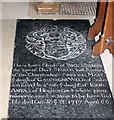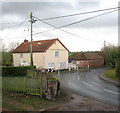1
St Mary the Virgin, Pulham St Mary
Pulham St Mary is a quiet village with a rather nice Perpendicular Church. The Church has possibly one of the most spectacular porches in either Norfolk and Suffolk.
Image: © Mike Snoswell
Taken: 27 Aug 2004
0.18 miles
2
St Mary's ornate churchyard gate
The gate into St Mary's > http://www.geograph.org.uk/photo/1593696 churchyard is situated at its south-eastern corner. The road seen beyond is The Street.
Image: © Evelyn Simak
Taken: 23 Nov 2009
0.18 miles
3
The Street, Pulham St Mary
Near St.Mary's Church
Road No.C877
Image: © Geographer
Taken: 22 Nov 2014
0.18 miles
4
Bridge on The Street
Road No.C877
Image: © Geographer
Taken: 22 Nov 2014
0.18 miles
5
St Mary's Church, Pulham St Mary, Norfolk - Ledger slab
Image: © John Salmon
Taken: 24 Oct 2008
0.19 miles
6
Pulham St. Mary: Pinnacle on the south porch
Image: © Michael Garlick
Taken: 22 Jun 2018
0.19 miles
7
Thatched cottage east of St Mary's church
The parish of Pulham St. Mary was originally known as Pulham St Mary the Virgin, reflecting the church of that name > http://www.geograph.org.uk/photo/1593696. There is ample evidence of the site having been inhabited since the Bronze Age and many Roman artefacts have been found in the area, which the Domesday book shows as one of the most populated in the country. Oyster shells (the Romans considered oysters a great delicacy) were found in considerable quantity during excavations in the garden of The Croft, an old thatched cottage > http://www.geograph.org.uk/photo/1593690 situated at the bottom of The Street, opposite the churchyard. A market was established in 1249 and the development of houses in the vicinity of the market area eventually gave rise to the separate parish of Pulham Market, a short distance to the north-west. Pulham became noted for the manufacture of hats, dornicks (a coarse kind of linen) and coverlets. Although the Pulhams today are two separate villages, they were for many years (until 1857) recognised as one parish. The village boasts a collection of old buildings - almost all timber-framed with wattle and daub infill - about 80 of which are listed as being of architectural and historic interest. Formerly the village had three inns and three windmills, none of which has survived. In modern history, Pulham St Mary became famous for its Airstation (in RAF ownership until 1958) where the airships ("Pulham Pigs") were sited from WWI. Until the 1960s there was a branch railway line that was used to take milk and vegetable produce to the London markets daily. Besides a few crossing keeper's cottages (now converted into private dwellings) nothing remains > http://www.geograph.org.uk/photo/1592863 in Pulham St Mary but the station in neighbouring Pulham Market still stands > http://www.geograph.org.uk/photo/1592892.
Image: © Evelyn Simak
Taken: 23 Nov 2009
0.19 miles
8
View south along The Street
The parish of Pulham St. Mary was originally known as Pulham St Mary the Virgin, reflecting the church of that name > http://www.geograph.org.uk/photo/1593696. There is ample evidence of the site having been inhabited since the Bronze Age and many Roman artefacts have been found in the area, which the Domesday book shows as one of the most populated in the country. Oyster shells (the Romans considered oysters a great delicacy) were found in considerable quantity during excavations in the garden of The Croft, an old thatched cottage > http://www.geograph.org.uk/photo/1593690 situated at the bottom of The Street, opposite the churchyard. A market was established in 1249 and the development of houses in the vicinity of the market area eventually gave rise to the separate parish of Pulham Market, a short distance to the north-west. Pulham became noted for the manufacture of hats, dornicks (a coarse kind of linen) and coverlets. Although the Pulhams today are two separate villages, they were for many years (until 1857) recognised as one parish. The village boasts a collection of old buildings - almost all timber-framed with wattle and daub infill - about 80 of which are listed as being of architectural and historic interest. Formerly the village had three inns and three windmills, none of which has survived. In modern history, Pulham St Mary became famous for its Airstation (in RAF ownership until 1958) where the airships ("Pulham Pigs") were sited from WWI. Until the 1960s there was a branch railway line that was used to take milk and vegetable produce to the London markets daily. Besides a few crossing keeper's cottages (now converted into private dwellings) nothing remains > http://www.geograph.org.uk/photo/1592863 in Pulham St Mary but the station in neighbouring Pulham Market still stands > http://www.geograph.org.uk/photo/1592892.
Image: © Evelyn Simak
Taken: 23 Nov 2009
0.19 miles
9
Path to St Mary's Church, Pulham St Mary, Norfolk
Image: © John Salmon
Taken: 24 Oct 2008
0.20 miles
10
St Mary's church - churchyard
View across the northern section of St Mary's > http://www.geograph.org.uk/photo/1593696 churchyard.
Image: © Evelyn Simak
Taken: 23 Nov 2009
0.21 miles











